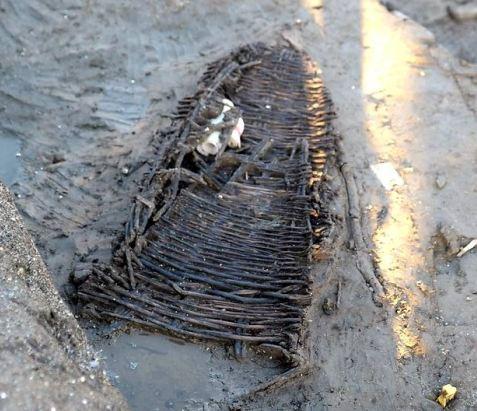Extraordinary Bronze Age artefacts discovered at Hanson quarry in Whittlesey
Tom Jackson
Source -http://www.cambstimes.co.uk/news/gallery_extraordinary_bronze_age_artefacts_discovered_at_hanson_quarry_in_whittlesey_1_1150410
One of the best preserved examples of prehistoric river life ever found in Britain has been unearthed at a Fenland quarry - including six logboats some 3,000 years old.

Major archaeology find at Must Farm, Hanson brickyard, Whittlesey. Mark Knight, senior project officer.
The extraordinary find at Hanson’s quarry in Must Farm, Whittlesey, has doubled the total of Bronze Age logboats found in the UK.
One of the logboats could date from as long ago as 1300BC - making it the oldest ever discovered.
Swords, spears, fish weirs and eel traps have also been found in the ancient water course, which runs along the southern ends of the Flag Fen Basin. It is home to the Oxford Clay that Hanson uses to create its bricks.
Even the stumps of trees, which once lined the river, have been uncovered.

Major archaeology find of several oak tree carved boats dating back 1300BC at Must Farm, Hanson brickyard, Whittlesey.
Mark Knight, senior project officer for Cambridge Archaeological Unit, which is carrying out the excavation, said: “It’s archaeology like it’s never been preserved before.”
Mr Knight said that Mark Dunkley, maritime designation officer at English Heritage, described the finds as “rewriting history” when he visited the site.
Archaeologists are now in the middle of the painstaking task of cleaning the logboats, eel traps and fish weirs before they are removed from the channel.
The site is also being scanned with lasers in the hope of creating a 3D model of what the channel would have looked like 3,000 years ago.
Conditions ‘perfect for preservation’
Excavations are regularly carried out at the site under Cambridgeshire County Council planning regulations.
Mr Knight said: “The most important aspect of the site is the brickworks, the smoke coming out of Hanson’s chimneys. But we make sure that the archaeology of this landscape is given good treatment prior to the extraction of clay.
“Normally archaeologists use aerial photography or walk an area to find places to excavate but the Bronze Age is too deep below the surface. The only way to discover it is by digging a big hole and the only people or company doing that are Hanson at the brickworks - for the Oxford Clay which Hanson uses it has to dig about 20-30 metres deep.
“So we are making full use of our opportunity to excavate this site. What’s more, the soil is soft and it’s wet - perfect for preservation.”
Mr Knight said: “A group of Bronze Age academics came here two weeks ago and were gobsmacked. Most archaeological sites you go to there is a hole in the ground and an archaeologists will tell you about it. Here, you are standing in a Bronze Age channel looking at it.
“You don’t have to be an archaeologist to savour this.”
He added: “We don’t think we are good archaeologists, we think what we are finding might be typical of the rest of Fenland.
“The channel heads towards Peterborough in one direction and towards March in another - we think excavations will reveal more of the same.
"It’s archaeology like it’s never been preserved before."
Mark Knight, senior project officer for Cambridge Archaeological Unit.
“This couldn’t have happened without the brickworks being here - the brickworks and archaeology are inseparable.”
Kerry Murrell, site director for the excavation, said: “I have never worked on a site like this before. It has been a privilege to do so - everyone who has visited says they want to work here because it is exceptional.
“We will be in this landscape for as long as there is smoke coming from Hanson’s chimneys - and we could find more of the same or something even better next year.”

Major archaeology find of several oak tree carved boats dating back 1300BC at Must Farm, Hanson brickyard, Whittlesey.
PART. 2